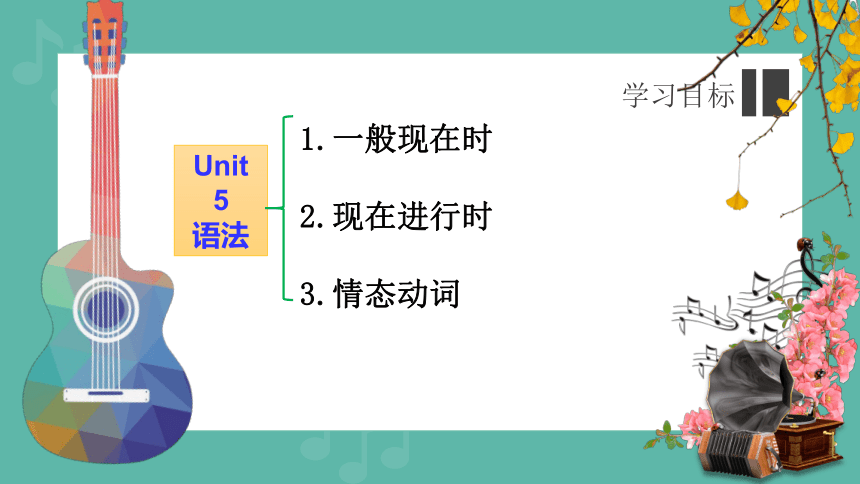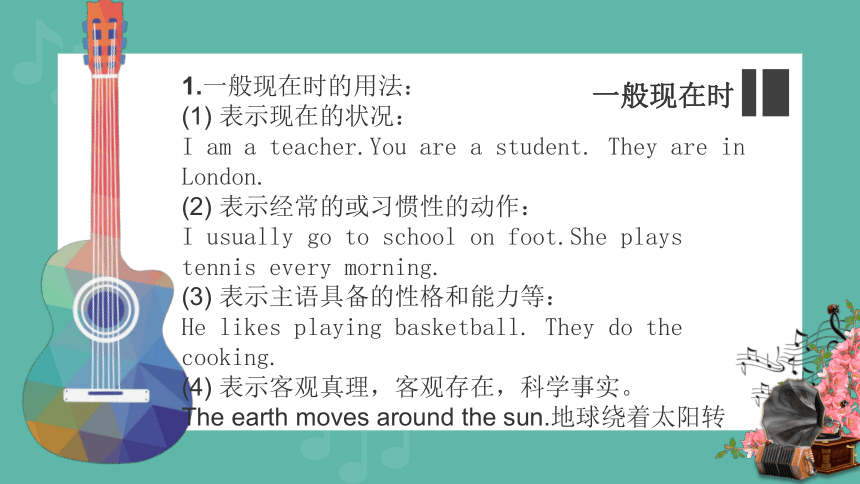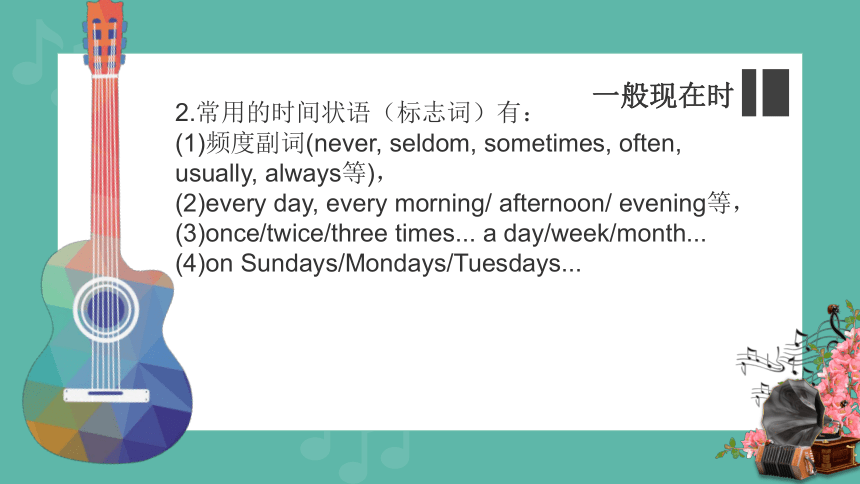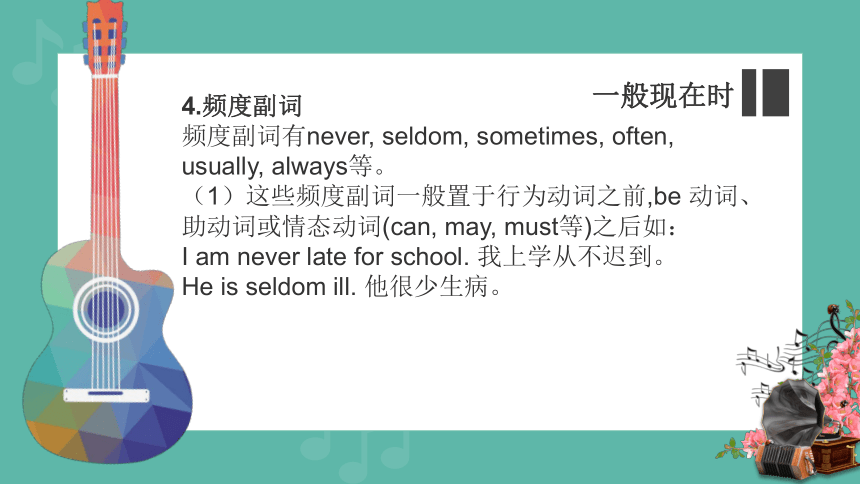仁爱版英语七年级下Unit 5 Our school life语法复习课件(21张PPT无素材)
文档属性
| 名称 | 仁爱版英语七年级下Unit 5 Our school life语法复习课件(21张PPT无素材) |  | |
| 格式 | zip | ||
| 文件大小 | 17.9MB | ||
| 资源类型 | 教案 | ||
| 版本资源 | 仁爱科普版 | ||
| 科目 | 英语 | ||
| 更新时间 | 2020-06-12 00:34:37 | ||
图片预览









文档简介
(共21张PPT)
Unit
5
语法复习
学习目标
Unit
5
语法
1.一般现在时
2.现在进行时
3.情态动词
一、一般现在时
1.一般现在时的用法:(1)
表示现在的状况:I
am
a
teacher.You
are
a
student.
They
are
in
London.(2)
表示经常的或习惯性的动作:I
usually
go
to
school
on
foot.She
plays
tennis
every
morning.(3)
表示主语具备的性格和能力等:He
likes
playing
basketball.
They
do
the
cooking.(4)
表示客观真理,客观存在,科学事实。The
earth
moves
around
the
sun.地球绕着太阳转
一般现在时
2.常用的时间状语(标志词)有:
(1)频度副词(never,
seldom,
sometimes,
often,
usually,
always等),
(2)every
day,
every
morning/
afternoon/
evening等,
(3)once/twice/three
times...
a
day/week/month...
(4)on
Sundays/Mondays/Tuesdays...
一般现在时
3.行为动词的一般现在时(1)肯定句结构:主语+
动词原形
/
第三人称单数形式+
其它I/
You/
We
/They
often
go
to
school
by
bike.(主语不是第三人称单数,谓语动词用原形)He/
She
often
goes
to
school
by
bike.(主语是第三人称单数,谓语动词用第三人称单数)
一般现在时
(2)肯定句变否定句时,主语不是第三人称单数的在行为动词前加don’t;主语为第三人称单数的在行为动词前加doesn’t,同时谓语动词还原为原形。如:I
go
to
school
by
bike.→
I
don’t
go
to
school
by
bike.He
goes
to
school
by
bike.→
He
doesn’t
go
to
school
by
bike.
一般现在时
(3)陈述句变一般疑问句时,
主语为非第三人称单数时在句首加助动词do.
主语为第三人单数时,在句首加助动词does,同时谓语动词也要用原形如:I
go
to
school
by
bike.→
Do
you
go
to
school
by
bike?He
goes
to
school
by
bike.→
Does
he
go
to
school
by
bike?
一般现在时
4.频度副词频度副词有never,
seldom,
sometimes,
often,
usually,
always等。(1)这些频度副词一般置于行为动词之前,be
动词、助动词或情态动词(can,
may,
must等)之后如:I
am
never
late
for
school.
我上学从不迟到。He
is
seldom
ill.
他很少生病。
一般现在时
(2)有时为了表示强调,也可放在句首或句末a)
Sometimes
I
go
to
the
park
on
foot.对频度副词提问时,疑问词用
how
oftene.g.)
We
go
to
the
library
sometimes.
(对划线部分提问)→How
often
do
you
go
to
the
library?如:---How
often
do
you
go
to
the
movies?
你多长时间看一次电影?---Seldom.
/
Once
a
week.
很少。/
一周一次
一般现在时
二、现在进行时
现在进行时
1.现在进行时表示:
(1)现在进行时表示正在发生或进行的动作,可与now=at
the
moment现在,
look看,listen听的提醒动作,等时间状语连用
e.g
I’m
reading
a
book
now.我正在看书。
(2)
现在进行时表示当前一段时间内一直进行的动作e.g
They’re
working
on
a
farm
this
week.
这个星期他们在农场干活。
现在进行时
(3)
某些行为动词的现在进行时形式可以表示将来,
常常有意图,安排或打算的含义,
并且可与表将来的时间状语连用,
到目前我们所学的这类动词有come,
go,
fly,
return
e.g
They
are
flying
to
London
this
afternoon.
他们今天下午飞往伦敦。
We
are
going
to
Hong
Kong
tomorrow.
我们明天要去香港。
Steve
is
coming
tomorrow
evening.
史蒂夫明天晚上来。
现在进行时
2.常用的时间状语:now,
at
the
moment,
提醒动作发生的动词look,
listen等。
3.谓语动词构成:be(am/is/are)+v.-ing形式。
4.动词的-ing形式构成:
5.现在进行时态的肯定、否定和疑问式。
(1)肯定句:主语+be+doing+sth
I
am
running.
He/She
is
running.
(2)否定句:主语+be+not+doing+sth
I’m
not
running.
He/She
isn’t
running.
现在进行时
(3)一般疑问句:Be+主语+doing+sth
回答:Yes,主(代)+be
/No,主(代)+be+not.
Are
you
running?
—Yes,
I
am./—No,
I
am
not.
Is
he/she
running?
—Yes,
he/she
is./
—No.
he/she
isn’t
(4)特殊疑问句:?What+be+主语+doing?
三、情态动词
情态动词
1.句子结构:can+动词原形,情态动词,不随主语和数而变化。
(1)含有can的肯定句:主语+can+谓语动词的原形+其他。
(2)变一般疑问句时,把can提前:Can+主语+动词原形+其他?
肯定回答:Yes,主语+can。
否定回答:No,主语+can't.
(3)含有can的否定句:主语+can't+动词的原形+其他。
情态动词
(4)含有can的特殊疑问句:特殊疑问词+can+主语+动词原形+其他?
2.may+动词的原形。(may为情态动词)
一般疑问句是把may提前,
肯定回答是:Yes,主语
+may。
否定回答是:No,主语+mustn't。或please
don't。
情态动词
?3.have
to?后加动词原形,侧重客观的需要,
有“不得不,被迫”之意,有多种时态形式,
否定式为don’t
have
to(needn’t)意为“不必”。?
must
侧重于说话者的主观看法,
认为有必要或有义务做某事,只有现在时一种形式,
否定式mustn’t意为“一定不要,不允许,禁止”
反意词为“needn’t”。
知识回顾
Unit
5
语法
1.一般现在时
2.现在进行时
3.情态动词
Thank
you!
Unit
5
语法复习
学习目标
Unit
5
语法
1.一般现在时
2.现在进行时
3.情态动词
一、一般现在时
1.一般现在时的用法:(1)
表示现在的状况:I
am
a
teacher.You
are
a
student.
They
are
in
London.(2)
表示经常的或习惯性的动作:I
usually
go
to
school
on
foot.She
plays
tennis
every
morning.(3)
表示主语具备的性格和能力等:He
likes
playing
basketball.
They
do
the
cooking.(4)
表示客观真理,客观存在,科学事实。The
earth
moves
around
the
sun.地球绕着太阳转
一般现在时
2.常用的时间状语(标志词)有:
(1)频度副词(never,
seldom,
sometimes,
often,
usually,
always等),
(2)every
day,
every
morning/
afternoon/
evening等,
(3)once/twice/three
times...
a
day/week/month...
(4)on
Sundays/Mondays/Tuesdays...
一般现在时
3.行为动词的一般现在时(1)肯定句结构:主语+
动词原形
/
第三人称单数形式+
其它I/
You/
We
/They
often
go
to
school
by
bike.(主语不是第三人称单数,谓语动词用原形)He/
She
often
goes
to
school
by
bike.(主语是第三人称单数,谓语动词用第三人称单数)
一般现在时
(2)肯定句变否定句时,主语不是第三人称单数的在行为动词前加don’t;主语为第三人称单数的在行为动词前加doesn’t,同时谓语动词还原为原形。如:I
go
to
school
by
bike.→
I
don’t
go
to
school
by
bike.He
goes
to
school
by
bike.→
He
doesn’t
go
to
school
by
bike.
一般现在时
(3)陈述句变一般疑问句时,
主语为非第三人称单数时在句首加助动词do.
主语为第三人单数时,在句首加助动词does,同时谓语动词也要用原形如:I
go
to
school
by
bike.→
Do
you
go
to
school
by
bike?He
goes
to
school
by
bike.→
Does
he
go
to
school
by
bike?
一般现在时
4.频度副词频度副词有never,
seldom,
sometimes,
often,
usually,
always等。(1)这些频度副词一般置于行为动词之前,be
动词、助动词或情态动词(can,
may,
must等)之后如:I
am
never
late
for
school.
我上学从不迟到。He
is
seldom
ill.
他很少生病。
一般现在时
(2)有时为了表示强调,也可放在句首或句末a)
Sometimes
I
go
to
the
park
on
foot.对频度副词提问时,疑问词用
how
oftene.g.)
We
go
to
the
library
sometimes.
(对划线部分提问)→How
often
do
you
go
to
the
library?如:---How
often
do
you
go
to
the
movies?
你多长时间看一次电影?---Seldom.
/
Once
a
week.
很少。/
一周一次
一般现在时
二、现在进行时
现在进行时
1.现在进行时表示:
(1)现在进行时表示正在发生或进行的动作,可与now=at
the
moment现在,
look看,listen听的提醒动作,等时间状语连用
e.g
I’m
reading
a
book
now.我正在看书。
(2)
现在进行时表示当前一段时间内一直进行的动作e.g
They’re
working
on
a
farm
this
week.
这个星期他们在农场干活。
现在进行时
(3)
某些行为动词的现在进行时形式可以表示将来,
常常有意图,安排或打算的含义,
并且可与表将来的时间状语连用,
到目前我们所学的这类动词有come,
go,
fly,
return
e.g
They
are
flying
to
London
this
afternoon.
他们今天下午飞往伦敦。
We
are
going
to
Hong
Kong
tomorrow.
我们明天要去香港。
Steve
is
coming
tomorrow
evening.
史蒂夫明天晚上来。
现在进行时
2.常用的时间状语:now,
at
the
moment,
提醒动作发生的动词look,
listen等。
3.谓语动词构成:be(am/is/are)+v.-ing形式。
4.动词的-ing形式构成:
5.现在进行时态的肯定、否定和疑问式。
(1)肯定句:主语+be+doing+sth
I
am
running.
He/She
is
running.
(2)否定句:主语+be+not+doing+sth
I’m
not
running.
He/She
isn’t
running.
现在进行时
(3)一般疑问句:Be+主语+doing+sth
回答:Yes,主(代)+be
/No,主(代)+be+not.
Are
you
running?
—Yes,
I
am./—No,
I
am
not.
Is
he/she
running?
—Yes,
he/she
is./
—No.
he/she
isn’t
(4)特殊疑问句:?What+be+主语+doing?
三、情态动词
情态动词
1.句子结构:can+动词原形,情态动词,不随主语和数而变化。
(1)含有can的肯定句:主语+can+谓语动词的原形+其他。
(2)变一般疑问句时,把can提前:Can+主语+动词原形+其他?
肯定回答:Yes,主语+can。
否定回答:No,主语+can't.
(3)含有can的否定句:主语+can't+动词的原形+其他。
情态动词
(4)含有can的特殊疑问句:特殊疑问词+can+主语+动词原形+其他?
2.may+动词的原形。(may为情态动词)
一般疑问句是把may提前,
肯定回答是:Yes,主语
+may。
否定回答是:No,主语+mustn't。或please
don't。
情态动词
?3.have
to?后加动词原形,侧重客观的需要,
有“不得不,被迫”之意,有多种时态形式,
否定式为don’t
have
to(needn’t)意为“不必”。?
must
侧重于说话者的主观看法,
认为有必要或有义务做某事,只有现在时一种形式,
否定式mustn’t意为“一定不要,不允许,禁止”
反意词为“needn’t”。
知识回顾
Unit
5
语法
1.一般现在时
2.现在进行时
3.情态动词
Thank
you!
同课章节目录
- Unit 5 Our school life
- Topic 1 I usually come to school by subway.
- Topic 2 A few students are running around the play
- Topic 3 My school life is very interesting.
- Unit 6 Our local area
- Topic 1 Is there a computer in your study?
- Topic 2 My home is in an apartment building.
- Topic 3 Which is the way to the hospital?
- Review of Units 5-6
- Unit 7 The Birthday
- Topic 1 When is your birthday?
- Topic 2 Can you sing an English song?
- Topic 3 Everyone had a good time.
- Unit 8 The seasons and the Weathe
- Topic 1 What's the weather like in summer?
- Topic 2 The summer holidays are coming.
- Topic 3 Let’s celebrate!
- Review of Units 7-8
- 旧版资料
- Unit 5 Our School Life
- Unit 6 Our Local Area
- Unit 7 The Birthday
- Unit 8 The seasons and the Weathe
- Unit 7 Celebrating the Birthday(老版本)
